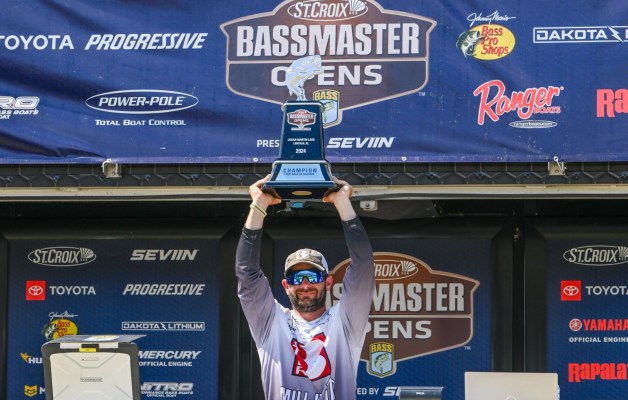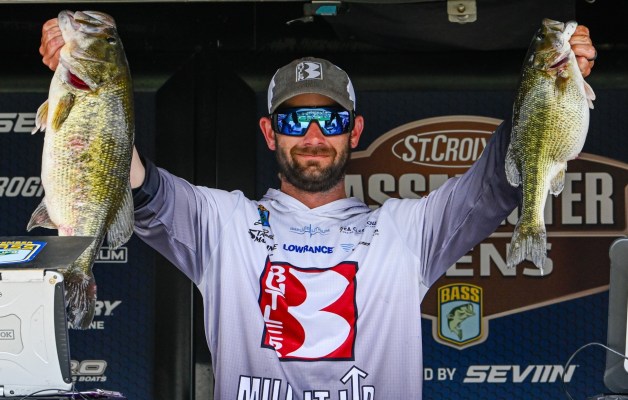
CLARKSVILLE, Va. — It felt more like the beginning of March than the beginning of May on the first day of the St. Croix Bassmaster Open at Buggs Island. Temperatures barely made it into the 60s while high winds gusting as high as 30 mph across the lake made navigation and casting rather difficult.
“It is not normal for May. It is supposed to be in the 80s, and we are supposed to be wearing flip flops and shorts. I’m in jeans and three jackets. It feels like prespawn fishing, but you are catching postspawners,” Opens Elite Qualifier pro Kyle Austin remarked.
Those conditions are just one more curveball anglers had to factor in when trying to break down a fishery that quickly rose to 3 feet above full pool late in practice. But the field of 225 boats rose to the challenge for the most part.
While the overall bag size may not be as impressive as what we witnessed at Eufaula and Toledo Bend to start the season, the catch rates have mirrored those two events. All but four boaters brought at least one fish back to weigh-in while 160 pros caught limits.
Weights are tight as well, and there will be plenty of moving and shaking as conditions change on Day 2. Here is what we have learned so far at Buggs Island.
Shallow bite leads the charge early
The top four anglers after Day 1 were all fishing shallow around the flooded bushes and stumps. For leader Powell Kemp, who caught 19 pounds, 8 ounces, conditions couldn’t be much better for a local like himself to excel. He has spent hundreds of days on Buggs Island, and Wednesday was one of his best days ever on the lake.
“The lake did exactly what it needed for a local to have an advantage because I’ve seen so much over 20 years of fishing here,” he said. “Where I thought they were in practice, some of them moved further back (on Day 1). But there were some on the points, some on the sides and some in the backs. There was no rhyme or reason.”
“As rough as (the wind) was today, I had to bear down on one area. I couldn’t run and gun like I’m used to, but maybe that worked to my advantage.”
After just a day and a half of practice time, Brad Knight finds himself in second place with 16-8. The condition of the lake currently reminds Knight of what he has experienced on the Tennessee River in the past.
“The X-factor we have here is water clarity,” he added. “Some places you go in a creek and it’s really clear, and then you’ll move to a pocket and there will be really dirty water. Part of that adaptation is changing baits. Maybe it’s changing the blades on the spinnerbait, a color variation on a skirt or maybe the same bait, just a different color.”
Catching 16-6 to land in third, Jacob Thompkins said conditions were just about perfect for him on the first day of competition. He mentioned that when there are less bushes in a particular area, that is where the bigger bass tend to live. He mostly focused on bushes protected in the creeks.
“I’ve been flipping bushes and throwing a spinnerbait around bushes. The last time I was here for pre practice, I caught a 4-pounder off the bank on some stumps by LiveScoping them, and I caught my biggest one today on that same bank.”
For the Okie Dale Hightower, the high water conditions have allowed him to fish to his strengths. The wind today actually helped position the bass in predictable places for Hightower, which led to a 15-15 performance on Day 1.
“It is no secret the fish are in the bushes. There is something subtle to what I am doing,” he said. “It just got better and better as the day went along. You would pull up on an area, and it would be bang, bang.
“I got to do what I like to do today.”
Casey Scanlon got in on the shallow fun as well. He didn’t get to fish the majority of the water he wanted to on Day 1, but he was able to catch 14-11 to land in ninth. He caught close to a dozen keeper bass, mostly with a Trophy Bass Company spinnerbait.
Conditions this week have Scanlon feeling like he is back home on one of the Ozark Mountain lakes, which has made the learning curve a little easier.
“It was a fun day. We got a lot of bites this afternoon and got a cull with 10 minutes to go,” Scanlon said. “We experience a lot of high water situations on a lot of my home lakes. It fished very similar. It’s a pattern lake with lots of pockets and points. It very much reminded me of an Ozark lake.”
Offshore anglers salvage the day
The strong winds were not kind to anglers who were attempting to fish offshore on Day 1 at Buggs Island. The worst of it began to move through around 11 a.m., so the morning hours were critical for getting bites.
Clark Reehm spent a lot of time finding offshore rock piles and brush piles in practice, and he was able to capitalize on some protected offshore areas. He has caught bass in the 4- to 10-foot range to land in 11th with 14-3.
“The wind was a nuisance today,” he said. “I know it affected a lot of guys using Active Target and forward sonar. You couldn’t pinpoint any of the offshore fish. You could pinpoint them in practice and pick them off.
“(For me), there are specific things they are sitting on.”
That is exactly what happened to Kyle Patrick, who was able to salvage his day with a good morning bite to land in 27th with 13-3.
“The wind makes it really hard because I am doing a lot of LiveScoping,” New York pro Kyle Patrick said. “When you are bumping up and down and your trolling motor is coming out of the water, it is harder to stay on your target. I capitalized on an early bite and caught 11 pounds.”
Not only was it difficult to use a graph, it was difficult to even make a proper cast at times. Andrew Hargrove may be in 34th with 12-13, but he struggled to make adequate presentations.
“The way that I am fishing, the wind is really affecting it,” he explained. “I’m throwing a really small bait that’s lightweight. I’m trying to reel it over the fish and the boat will move off the spot and I can’t reel it slow enough to keep the bait down. If the wind will die down a little, I might get a few more bites.”
What will the water do next?
After a dramatic rise in water level during practice, several competitors noted that the water has stabilized and that has stayed true to start Day 2. That played into Thompkins hands on Wednesday around his shallow areas.
“Today was perfect. The water wasn’t going crazy today, up or down. It finally stayed the same for a day or two mostly,” Thompkins said.
Stabilization is also important for Hightower’s bush-flipping program.
“When the water stabilizes, that allows the fish to move on up. They aren’t confused,” Hightower said. “When the water is still rising, they don’t know where to be. It is starting to stabilize now and they are starting to move up.”
If the water begins to drop, that may not be the worst thing for Hightower, who thinks it will just position the bass in a different part of the bushes.
“Even if it falls, it will just reposition the fish to the outside. I’m good with seeing it drop, even if it comes down a foot,” he said.
Reehm would prefer the lake drop dramatically, which would hurt the shallow bite and bring the bass to the areas and pieces of structure he is fishing offshore.
“We didn’t really know if they were going to rip the water out of this place or not,” Reehm said. “That would drastically alter this tournament if they dropped it a foot overnight. Guys would really be scratching their heads. A lot of the fish aren’t accessible right now. If it starts dropping, they will pull out to the outer bushes and trees.”
But for Kemp, it would be the worst thing for his home field advantage.





